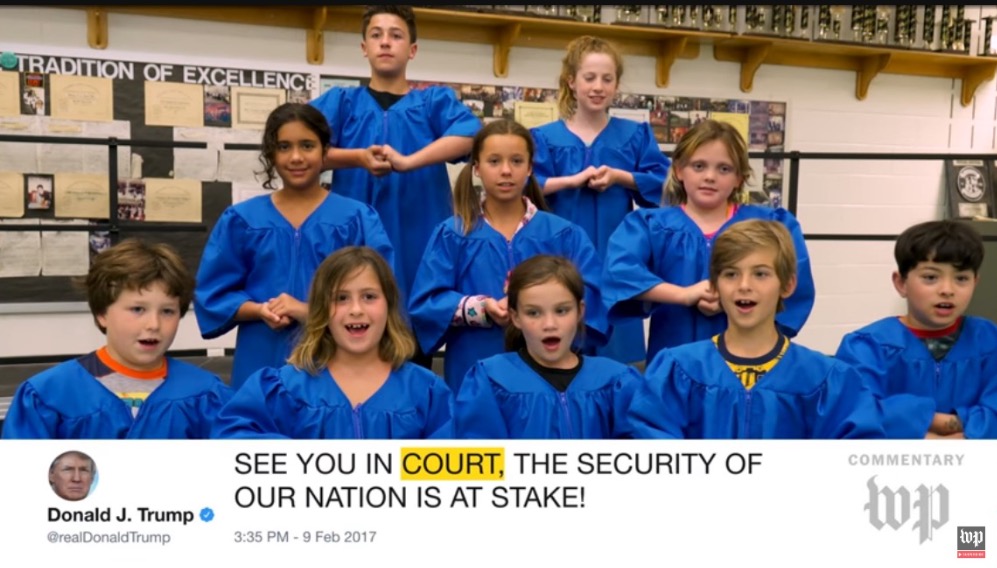
Making fun of both Apple and White House press secretary Sarah Huckabee Sanders at the same time isn’t easy, but The Washington Post somehow pulled it off. Earlier this month the newspaper’s video team published “Meet Sarah, the New Siri,” a short satirical video that used the stylings of Apple’s ads to poke fun at Sanders’ repeated — but often unfulfilled — assurances to reporters that “I’ll get back to you on that.”
These kinds of videos have become a familiar sight on The Washington Post over the past few months. In June, the Post tapped Veep actor Brian Huskey to reenact Anthony Scaramucci’s now-infamous on-the-record phone call New Yorker reporter Ryan Lizza. And in a recent video titled “Mean Boys: Dancing on the Debt Ceiling,” The Post explained the mounting debt ceiling crisis in the style of a character from the 2004 film Mean Girls.
For a newspaper whose new-ish slogan “Democracy Dies in Darkness” has been criticized by readers for being “demoralizing” and disturbing, the comedy videos can feel out of place. But Michelle Jaconi, executive producer of creative at the Post, argues otherwise: If you want more people to pay attention to the news, start by making them laugh.
“We have to give people different entry points to the news,” she said. She noted that The Washington Post has won three Pulitzer Prizes for its editorial cartooning, which she argued makes the humor videos less of a leap for a newspaper than people might think. “Humor is something the Post has always done. There’s already this great heritage and there is always a need to poke at the preciousness of people in power, whether they be media people or a company like Apple.”
Jaconi, who joined the Post from Independent Journal Review in April, has been charged with helping to staff The Washington Post’s video team, which has grown rapidly since the newspaper announced its ambitious three-year video expansion plans earlier this year. The newspaper started 2017 with a video team of 40 people; now that number hovers around 60, and is likely to pass 70 by the end of the year.In particular, Jaconi is focused on what Washington Post director of video Micah Gelman calls “destination video content,” which is different in style and substance from the kinds of video that the Post runs alongside the articles on its website. “The video we produce as part of the core reporting team is not something you come to us for. You come across that video while reading,” Gelman said. “Michelle’s very difficult task is to figure out how we get people to think of us as a video destination. That destination does not have to be washingtonpost.com.”
This so-called “distributed content” strategy has moved from novelty to table stakes for publishers in just a few years. Like most publishers today, the Post is intent on using platforms like Facebook, YouTube, and Apple News to increase the number of people it reaches with its videos. But embracing that strategy has also meant experimenting with both new story forms (“we’re not prescriptive about format,” said Gelman) as well as topics. Beyond politics, Jaconi’s team is experimenting with videos on subjects like health, food, and culture that are most primed to find big audiences on the social platforms.
Another core strategic imperative to the Post’s expanding video work is, as Jaconi puts it, “putting faces on the institution” of the Washington Post. This idea is core to the Post’s “Hate Mail” series, in which Post luminaries such as George Will and and Erik Wemple read readers’ comments from their articles and columns. These videos are designed to be both entertaining and to introduce viewers to the personalities behind the columns and stories they read on WashingtonPost.com.
This idea of creating a more visual representation of the Washington Post brand has also driven Jaconi’s focus on hiring on-screen talent such as Nicole Ellis from CNN, Hannah Jewell from Buzzfeed UK, and Anna Rothschild, the host of Gross Science, a YouTube series developed by NOVA and PBS Digital Studios. These reporters, she said, have the natural curiosity of journalists combined with the experience of working alongside small, fast-moving news video teams. “Now is a really important time for us to show, not just, tell what journalists do,” Jaconi said.
Gelman said that the primary challenge for The Washington Post’s video operation is figuring out how to “reposition the Post as a video-focused brand” while also continuing to invest in everything else the newspaper already produces. Unlike at Mic and MTV News, where text-based reporters have been laid off as part of the companies’ larger strategic shifts to video, The Washington Post wants video to exist in addition to its text reporting, not instead of it.
But building that video mindshare among viewers is a long-term process, as Gelmen stressed. “How do we get people to wake up in the morning or sit down on their couch in the evening and seek out the videos that we publish? That’s our big question,” he said.